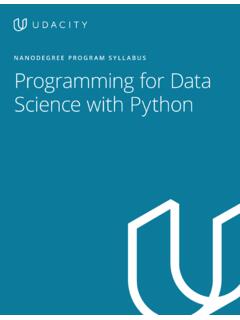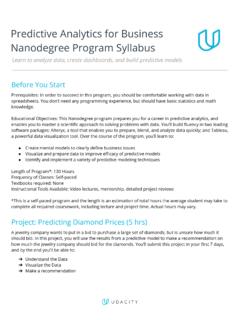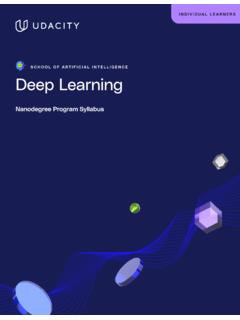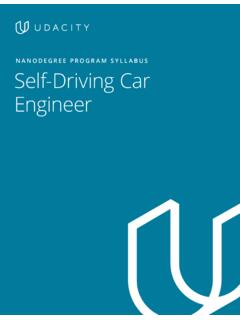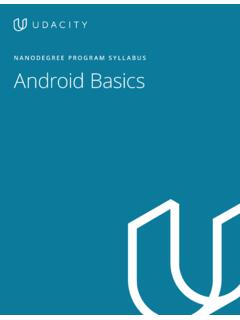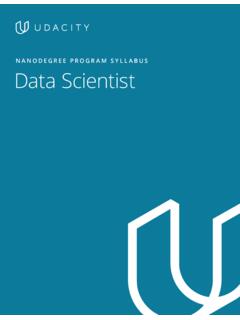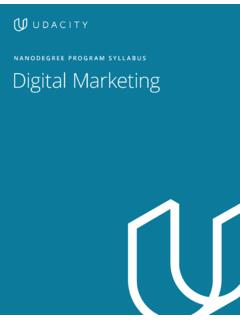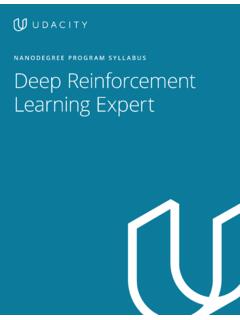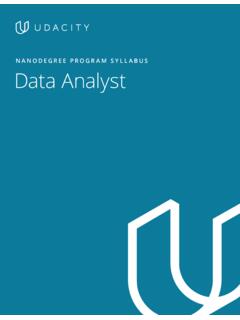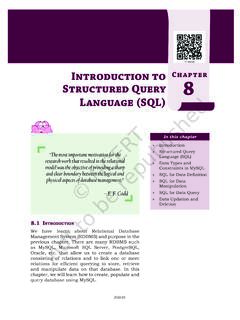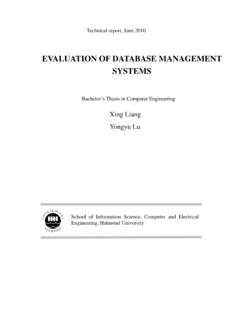Transcription of NANODEGREE PROGRAM SYLLABUS Full Stack Web Developer
1 Need Help? Speak with an Advisor: Stack Web DeveloperNANODEGREE PROGRAM SYLLABUSFull Stack Web Developer | 2 Need Help? Speak with an Advisor: goal of the Full Stack Web Developer NANODEGREE PROGRAM is to equip learners with the unique skillsthey need to build database-backed APIs and web applications. A graduate of this PROGRAM will be able to: Design and build a database for a software application Create and deploy a database-backed web API (Application Programming Interface) Secure and manage user authentication and access control for an application backend Deploy a Flask-based web application to the cloud using Docker and KubernetesThis PROGRAM includes 4 courses and 5 projects. Each project you build will be an opportunity toapply what you ve learned in the lessons and demonstrate to potential employers that you have practicalfull- Stack development : Prior experience with Python, CSS/HTML, and GitFlexible Learning: Self-paced, so you can learn on the schedule that works best for youEstimated Time: 4 Months at 5-10hrs/weekNeed Help?
2 Discuss this PROGRAM with an enrollment Stack Web Developer | 3 Need Help? Speak with an Advisor: 1: SQL and Data Modeling for the WebMaster relational databases with the power of SQL, and leverage Python to incorporate database logic into your OUTCOMESLESSON ONEC onnecting and Interactingwith Databases Describe and explain the client-server model Describe and explain the TCP/IP communication protocol Describe and explain the base unit of database work: transactions Install the postgresql database management system Create and manage Postgres databases with the psql client Install the psycopg2 Python+Postgres database driver Create and manage Postgres databases using the psycopg2 Python database driverCourse Project Design a Venue Booking DatabaseFor your first project, you ll be building out the data models and database for an artist/venue booking application.
3 The fictitious startup Fy-yur is building a website that facilitates bookings between artists who can play at venues, and venues who want to book artists. This site: Lets venue managers and artists sign up, fill out their information, and list their availability for shows. Lets artists browse venues where they can play, and see what past/upcoming artists have been booked at a venue. Lets a venue manager browse artists that would like to play in their city, and see what past/upcoming venues where the artist has played/will be goal of this project is to build out the data models for this booking application. A prototype design of the web app will be provided. You ll use SQLA lchemy and postgresql to build out the data models upon which this site will rely. You ll write out both the raw SQL and SQLA lchemy commands to run for poweringthe backend functionality of the Stack Web Developer | 4 Need Help?
4 Speak with an Advisor: TWOI ntro to SQLA lchemy andSQLA lchemy ORM Basics Describe and explain the use cases for an Object Relational Mapping (ORM) library Describe and explain the abstraction layers of SQLA lchemy Connect to and manage a database using composable SQL expressions Define data model objects with Python using SQLA lchemy ORM Connect data models to a lightweight Flask web application Build data models using different types of dataLESSON THREESQLA lchemy ORM in Depth Explore and retrieve data using the SQLA lchemy Model. query object Create database sessions for executing database transactions Execute database transactions within a connection session Describe and explain the SQLA lchemy object lifecycle Build a lightweight data app using SQLA lchemy Describe and explain the Model-View-Controller (MVC) application architecture Retrieve from data from a webform using Flask Update data models using data migrations Migrate data using Flask-Migrate and Flask-Script Define and code relationships between tables and objects using SQLA lchemy Implement database methods to query relationships between data modelsLESSON FOURB uild a CRUD App withSQLA lchemy ORM - Part 1 Use the CRUD (Create, Read, Update, Delete)
5 Model to build a small database backed app Capture user input from a webform to add and modify data to a database Manage data using database sessions in an application controllerLESSON FIVEM igrations Modify a data schema using Flask-Migrate and Alembic Write migration scripts to update data schemas using Flask- ScriptLESSON SIXB uild a CRUD App withSQLA lchemy ORM - Part 2 Update database models using webforms and application routing Delete information from a database using SQLA lchemy Model and control relationships between different types of data objects Implement one-to-many and many-to-many relationships using SQLA lchemy Execute complex database queries on related data modelsFull Stack Web Developer | 5 Need Help? Speak with an Advisor: 2: API Development and DocumentationLearn how to use APIs to control and manage web applications, including best practices for API testing and OUTCOMESLESSON ONEI ntroduction to APIs Describe and explain the definition and use cases of APIs (Application Programming Interface) Describe and explain how APIs are used to connect application front ends to server backendsLESSON TWOHTTP and Flask Basics Describe and explain the Hypertext Transfer Protocol (HTTP) Describe and explain the components of an HTTP request Describe and explain the different HTTP methods (verbs) Describe and explain HTTP status codes Request information from a server using cURL and HTTP requests Install the Python Flask micro application framework Set up and Configure a Flask application Create a Flask endpoint (route)Course Project.
6 Tr i v ia A PIIn this project, you will use the skills you ve developed to build a Trivia API. The API will allow users to: Search for trivia questions and answers via category and difficulty Add new questions Modify the difficulty rating of goal of this project is to use APIs to control and manage a web application using existing data models. You ll be given a set of data models and the application front end. Your task will be to implement the API in Flask to make the Trivia game Stack Web Developer | 6 Need Help? Speak with an Advisor: THREEE ndpoints and Payloads Structure and Organize API Endpoints Describe and explain Cross-Origin Resource Sharing (CORS) Manage CORS requests using HTTP headers Manage CORS controls using Flask-CORS Parse request path and body from an HTTP request Implement HTTP POST, PATCH and DELETE methods using Flask Handle application errors using FlaskLESSON FOURA PI Testing Describe and explain the purpose and benefits of API testing Test a REST API using Flask and unittest Develop an application iteratively and safely using Test Driven Development (TDD)LESSON FIVEAPI Documentation Read and explore API documentation from a number of API developers Write effective documentation for your own APIFull Stack Web Developer | 7 Need Help?
7 Speak with an Advisor: 3: Identity Access ManagementImplement authentication and authorization in Flask and understand how to design against key security principle. You will also gain experience with role-based control design patterns, securing a REST API, and applying software system risk and compliance OUTCOMESLESSON ONEF oundations Describe and explain the use cases and differences between authorization and authentication Describe the problem of security and the risks of unsecured or improperly secured application systems Describe different types of security attack Inspect requests and responses for an application using PostmanLESSON TWOA uthentication Describe common methods for application authentication Explain why passwords are not the ideal method for authentication Implement an application authentication layer with Auth0 Secure API communications using JSON Web Tokens ( JWT)
8 Course Project Identity Access ManagementIn the third project of the PROGRAM , you will build the backend for a coffee shop application. You ll add user accounts and authentication to your application and use role-based access management strategies to control different types of user behavior in the app. The application must: Display graphics representing the ratio of ingredients in each drink. Allow public users to view drink names and graphics. Allow the shop baristas to see the recipe information. Allow the shop managers to create new drinks and edit existing project will give you a hands-on chance to practice and demonstrate your new skills, such as: Implementing authentication and authorization in Flask Designing against key security principles Implementing role-based control design patterns Securing a REST API Applying software system risk and compliance principlesFull Stack Web Developer | 8 Need Help?
9 Speak with an Advisor: OUTCOMESLESSON ONEP asswords Describe the risks associated with password controlled systems Mitigate access risks associated with SQL injection by validating and sanitizing database inputs Secure database data in a database using standard encryption practices Describe how an attacker can use rainbow tables to gain access to a system Improve security of hashed passwords and encrypted data using the salt method Increase application security by using best practices to avoid logging and serializing sensitive dataLESSON TWOA uthorization Describe the concept of authorization and access control Define permissions in the context of an application Constrain permissions in an application by using role-based access control (RBAC) Define permission roles using Auth0 Identify user permissions and roles from JWTs ( JavaScript Web Tokens)LESSON THREET hinking Adversarially Prevent accidental access to privileged information in Git repositories by using environment variables Mitigate risks to Git master branch changes by developing in feature branches Employ code review as a practice to mitigate security risks Test API and authentication practices with integration testing Describe common types of adversarial attacks on network Stack Web Developer | 9 Need Help?
10 Speak with an Advisor: 4: Server Deployment and ContainerizationDevelop an understanding of containerized environments, use Docker to share and store containers, and deploy a Docker container to a Kubernetes cluster using AWSLEARNING OUTCOMESLESSON ONEC ontainers Describe and explain the benefits and use cases for containerized environments Install Docker on a local machine Define a container environment using a Dockerfile Download and launch a Docker container Store and share a docker containerCourse Project Deploy a Flask App to Kubernetes Using EKSC ourse Project Full Stack Web Developer NANODEGREE PROGRAM CapstoneIn this project, you will create a container for your Flask web app using Docker and deploy the container to a Kubernetes cluster using Amazon EKS. By the end of the project, you will have deployed your application live to the world, where it should be accessible by IP address.
